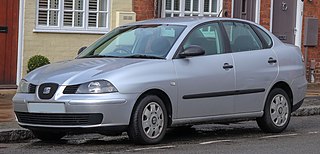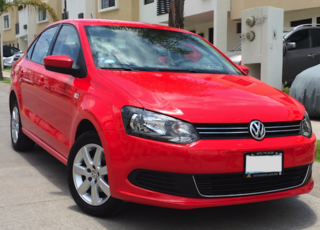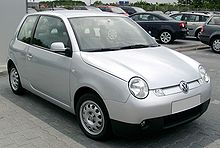
The Volkswagen Polo is a supermini car (B-segment) produced by the German car manufacturer Volkswagen since 1975. It is sold in Europe and other markets worldwide in hatchback, saloon, and estate variants throughout its production run.

The Audi A2 (internally designated Typ 8Z) is a lightweight compact MPV-styled supermini car, with a five-door hatchback body style and four or five seats, produced by the German manufacturer Audi from November 1999 (for the 2000 model year) to August 2005. Based on the Audi Al2 concept car first shown at the Frankfurt Motor Show in 1997, the A2 was notable for being constructed from aluminium, which in combination with its efficient engines, made it an extremely economical car on fuel.

The Volkswagen Sharan is a seven-seater minivan that was produced by the German Volkswagen Group and built at the AutoEuropa plant in Palmela, Portugal, with a front-wheel-drive version across two generations, from 1995 to 2022. Through badge engineering, the Volkswagen Sharan shares the same platform with the SEAT Alhambra, and the first generation was also in most respects identical to the Ford Galaxy. From 2010 to 2023 the Sharan was in its second generation. It is described in the motor industry as a multi-purpose vehicle (MPV).

The Volkswagen Touran is a car manufactured by German automaker Volkswagen since 2003 and sold in Europe and other select markets. A compact multi-purpose vehicle (MPV), it fills a gap in Volkswagen's model lineup between the Volkswagen Golf, with which it shares its platform, and the Volkswagen Sharan, its larger counterpart, which ceased production in 2022. The vehicle has been sold in Japan as the Golf Touran and the crossover-styled variant as the CrossTouran. The name 'Touran' is derived from the combination of 'Tour' and 'Sharan'. Despite the similarity of their names, the Touran is not related to the North American market Volkswagen Routan. The vehicle is delivered in five or seven seat versions.

The SEAT Arosa is a city car that was manufactured by the Spanish automaker SEAT from 1997 to 2004. The model débuted in March 1997 at the Geneva Motor Show, while its facelifted version was presented in October 2000 at the Paris Motor Show. It shared a platform with the Volkswagen Lupo and was mostly identical apart from equipment, styling and trim levels.

The Škoda Fabia is a series of passenger cars produced by Czech manufacturer Škoda Auto since 1999. It is the successor of the Škoda Felicia, which was discontinued in 2001. The Fabia was available in hatchback, estate and saloon body styles at launch, and from 2007, the second generation was offered in hatchback and estate versions. The third generation Fabia was launched in 2015, and the fourth in 2021.

The SEAT Córdoba is the saloon, estate and coupé version of the SEAT Ibiza supermini car, built by the Spanish automaker SEAT. It was manufactured between 1993 and 2008, and was related to the second and third generations of the Ibiza.

A direct-shift gearbox is an electronically controlled, dual-clutch, multiple-shaft, automatic gearbox, in either a transaxle or traditional transmission layout, with automated clutch operation, and with fully-automatic or semi-manual gear selection. The first dual-clutch transmissions were derived from Porsche in-house development for the Porsche 962 in the 1980s.

The Volkswagen Vento is a subcompact car produced by the Volkswagen India and Volkswagen Russia subsidiaries of the German manufacturer Volkswagen since 2010. It is essentially a three-box Volkswagen Polo with a stretched wheelbase and has been developed especially for some markets. The car is sold under the Vento nameplate in India, Malaysia, Brunei and Mexico. In Thailand, South Africa, Argentina, Russia, Jordan, Morocco, Algeria, Tunisia and the Middle East, it is sold as the Volkswagen Polo Sedan. The name Vento means 'wind' in both Italian and Portuguese. It is also known as the Volkswagen Polo Notch in the Philippines.

The Volkswagen Polo Mk4 is the fourth generation of the Volkswagen Polo supermini car produced by the German manufacturer Volkswagen. It was marketed from early 2002 to 2010 in most countries except Argentina and the USA. It was manufactured in South Africa until 2017, it was sold as the Polo Vivo. The Mk4 replaced the Volkswagen Polo Mk3, while the Polo Vivo replaced the Citi Golf. In 2018 the Mk4 was replaced by the Volkswagen Polo Mk5 Polo Vivo. In Brazil, It was manufactured until 2014 with a second facelift called 9n4, It was replaced in 2017 by Volkswagen Polo Mk6.

The Volkswagen Polo Mk3 is the third generation of the Volkswagen Polo supermini car and was produced from 1994 until 2002, with a facelift at the end of 1999. It was available in hatchback, sedan and wagon body styles. Although the Polo Mk3 hatchback didn't share the same platform as the Seat Ibiza, saloon and estate models were rebadged as Seat Córdoba.

The Volkswagen Golf Mk5 is a compact car/small family car manufactured and marketed by Volkswagen, as the fifth generation of the Golf in three- or five-door hatchback and a five-door station wagon (2007–2009) configurations, as well as the successor to the Golf Mk4. Using the Volkswagen Group A5 (PQ35) platform, the Mk5 debuted at the Frankfurt Motor Show in October 2003 and went on sale in Europe for the 2004 model year. While marketed as the Volkswagen Rabbit in the United States and Canada, the GTI model in these countries was marketed simply as the Volkswagen GTI.

The Volkswagen Golf Mk4 is a compact car, the fourth generation of the Volkswagen Golf and the successor to the Volkswagen Golf Mk3. Launched in October 1997 for the 1998 model year, it was the best selling car in Europe in 2001.

The Volkswagen Up is a city car produced by the Volkswagen Group from 2011 to 2023. It was unveiled at the 2011 International Motor Show Germany (IAA). Production of the Up started with the model year of 2012, in December 2011 at the Volkswagen Plant in Bratislava, Slovakia. It is part of the New Small Family (NSF) series of models, alongside the SEAT Mii and Škoda Citigo which are rebadged versions of the Up, with slightly different front and rear fascias. The SEAT and Škoda versions were manufactured in the same factory, before being withdrawn from sale in 2021 and 2020 respectively. Production of the Up ended in October 2023. A battery electric version, called E-up, was launched in autumn 2013.

The Volkswagen Golf Mk6 is a compact car and the sixth generation of the Volkswagen Golf. The Volkswagen Golf Mk6 is the successor to the Volkswagen Golf Mk5 and It was unveiled at the Paris Motor Show in October 2008 for the 2009 model year. Volkswagen released pictures and information on August 6, 2008, prior to the official unveiling. The vehicle was released to the European market in the winter of 2008. Volkswagen claimed investments were made in production efficiency, with a claimed productivity improvement at launch of nearly 20% in comparison with the previous model, with further gains planned for the first twelve months of production. This model year was also a part of the Dieselgate scandal.

The Volkswagen Polo Mk5 is the fifth generation of the Polo, a supermini-class car manufactured by Volkswagen since 2009. The vehicle unveiled at the 2009 Geneva Motor Show in March 2009, while the three-door version was unveiled at the 2009 Frankfurt Motor Show in September 2009. A four-door long-wheelbase sedan version has been produced and sold outside Europe in several emerging markets since 2010 either as the Volkswagen Vento or the Volkswagen Polo sedan. A short-wheelbase sedan version was sold in India between 2016 and 2020 as the Volkswagen Ameo.

The Volkswagen Golf (Mk7) is a C-segment car manufactured by German automobile manufacturer Volkswagen. It is the seventh generation in the Golf series and the successor to the Golf Mk6. It was introduced in Berlin on 4 September 2012, before a public launch at the 2012 Paris Motor Show. Sales in Europe began with the model in November 2012.

Volkswagen R is the brand used by the German auto manufacturer Volkswagen to indicate a sport or high performance model. An "R" badge is placed on the grille, front fenders and trunk of R-model vehicles to indicate the vehicle's trim level.

The Volkswagen Jetta (A6) is a compact car, the sixth generation of the Volkswagen Jetta and the successor to the Jetta (A5). Known as the NCS during its development, it was released in 2010 and was phased out since 2018 to make way for the Jetta (A7). The A6 Jetta is notable for leaving the premium positioning in the compact car segment, a strategy employed by Volkswagen to increase volume in the North American market. It also marked the departure from being a sedan derivative of the Golf, opting for a dedicated bodywork instead.

The Volkswagen Golf (Mk8) is a compact car, the eighth generation of the Volkswagen Golf and the successor to the Volkswagen Golf Mk7. It was launched in Wolfsburg on 24 October 2019, and arrived in German showrooms in December 2019.



























